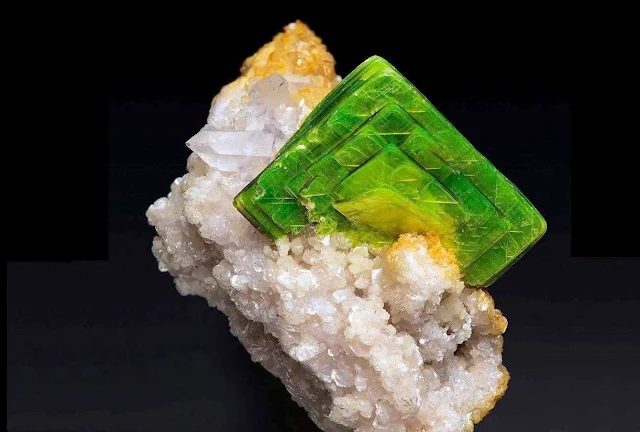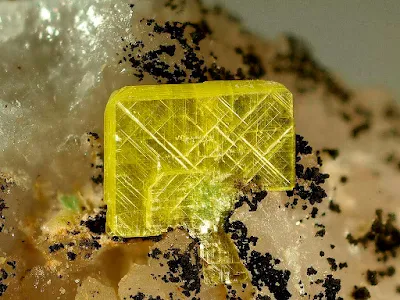Autunite: Properties, Occurrence, Uses
Autunite is a phosphate mineral containing uranium, appearing as yellow-green fluorescent crystals. It is mainly known for its use as a uranium ore.
Autunite is a hydrated calcium uranyl phosphate mineral with the chemical formula Ca(UO₂)₂(PO₄)₂·10–12H₂O.
Autunite is a product of the alteration of uraninite. It is the most common surface uranium mineral, abundant in the oxidation zones of uranium deposits ; it is also found more rarely in pegmatitic veins containing uranium and in some hydrothermal veins.
Autunite crystallizes in the orthorhombic system and often occurs as tabular square crystals, commonly in small crusts or in fan-like masses. Due to the moderate uranium content of 48.27% it is radioactive and also used as uranium ore. Autunite fluoresces bright green to lime green under UV light. The mineral is also called calco-uranite, but this name is rarely used and effectively outdated.
 |
| Autunite Radioactive Mineral. Unique Autunite (Meta-Autunite) from Golconda pegmatite district, Brazil. Photo: Thomas Spann |
Autunite is a radioactive orthorhombic mineral which results from the hydrothermal alteration of uranium minerals. Used as a uranium ore, it was first discovered in France in 1852.
The crystals have the shape of thin plates with very nearly square outline (89° 17′ instead of 90°). An important character is the perfect micaceous cleavage parallel to the basal plane, on which plane the lustre is pearly.
The colour is sulphur-yellow, and this enables the mineral to be distinguished at a glance from the emerald-green torbernite. Hardness 2-2½; specific gravity 3.05-3.19. Autunite is usually found with pitchblende and other uranium minerals, or with ores of silver, tin and iron; it sometimes coats joint-planes in gneiss and pegmatite.
Autunite is a radioactive mineral and can be harmful to human health. The radiation from autunite can cause cancer and other health problems. It is important to handle autunite with care and to avoid exposure to its radiation.
Properties of Autunite
- Chemical Formula: Ca(UO₂)₂(PO₄)₂·10–12H₂O
Crystal system: Orthorhombic - Color: Lemon-yellow to sulfur-yellow, greenish yellow to pale green; may be dark green to greenish black
- Crystal habit: Tabular crystals, foliated or scaly aggregates, and in crusts
Occurrence: A secondary mineral derived from primary uranium-bearing minerals under.
It is a radioactive mineral that reacts very strongly to UV with a very characteristic green fluorescence. Autunite is an important uranium ore. It is also popular with collectors.
 |
| Autunite Radioactive Mineral. Photo Copyright: Enrico Bonacina |
- Associated Minerals are torbernite, meta-torbernite, uranocircite, uranophane, uraninite and other uranium minerals.
- Other Characteristics: fluorescent yellow-green, radioactive, somewhat pleochroic and thin crystals or cleavage sheets are bendable.
- Notable Occurences include Autun, France; Cornwall, England; Mitchell Co., North Carolina and Mt. Spokane, Washington, USA; Zaire; Bergen, Germany and Portugal.
- Best Field Indicators are color, crystal habit, fluorescence, radioactivity, associations and flexible crystals.
Autunite Occurrence
Autunite is a mineral found in granitic rocks worldwide, occurring in various geological settings like:
Oxidation zones of uranium deposits: This is the most common occurrence, where autunite forms as an alteration product of primary uranium minerals like uraninite.
Hydrothermal veins: Hot mineral-rich fluids transport and deposit uranium, leading to autunite formation within these veins.
Granite pegmatites: These coarse-grained igneous rocks can contain pockets of uranium minerals, sometimes including autunite.
Where is Autunite found?
Autunite, a fluorescent yellow-green mineral known primarily as a uranium ore, can be found in various locations worldwide. Here are some notable areas where it's been discovered:
France: The type locality for Autunite is in Autun, France, where the mineral was first identified in 1852. Other significant deposits occur in the Massif Central and Brittany regions.
Portugal: The Viseu district in Portugal boasts some impressive Autunite crystals, often found on smoky quartz.
Germany: Large Autunite crystals have been found in the Vogtland region of Germany.
United States: The Daybreak Mine near Spokane, Washington, is known for its beautiful fan-like groups of Autunite crystals. Other notable deposits are found in South Dakota, Colorado, and Arizona.
Brazil: The Malacacheta pegmatite in Minas Gerais, Brazil, produces aesthetic Autunite crystals.
Australia: Mount Painter Mine: This mine in South Australia has yielded massive Autunite veins containing good crystals.
Uses and Applications of Autunite
Here are the main uses of Autunite:
1. Uranium Ore: Due to its moderate uranium content of 48.27%, Autunite is the most significant use. Uranium is a vital element in nuclear power generation, where nuclear fission releases immense energy. However, it's crucial to handle Autunite with extreme caution due to its radioactivity.
2. Cathode in Photoelectric Tubes: In the past, Autunite was used as a cathode in photoelectric tubes. These tubes convert light into electricity and were once widely used in electronics like early televisions and burglar alarms. However, photoelectric tubes have been largely replaced by more advanced technologies.
3. Historical Use in Ceramics: Autunite's beautiful yellow-red color made it a sought-after material for creating ceramic glazes. However, due to its radioactivity, this practice is no longer considered safe and has been discontinued.
4-Potential Future Uses:
Research is ongoing to explore potential future uses of autunite beyond its uranium content. These include:
Recovery of other elements: Autunite contains trace amounts of other valuable elements like vanadium and rare-earth metals, which could be extracted using advanced techniques.
Environmental remediation: Autunite's ability to absorb certain pollutants could be used for environmental cleanup applications.
It's important to note that due to its radioactive nature, autunite requires careful handling and safety precautions. It should only be handled by trained professionals and stored in appropriate facilities.

%20(1).webp)






